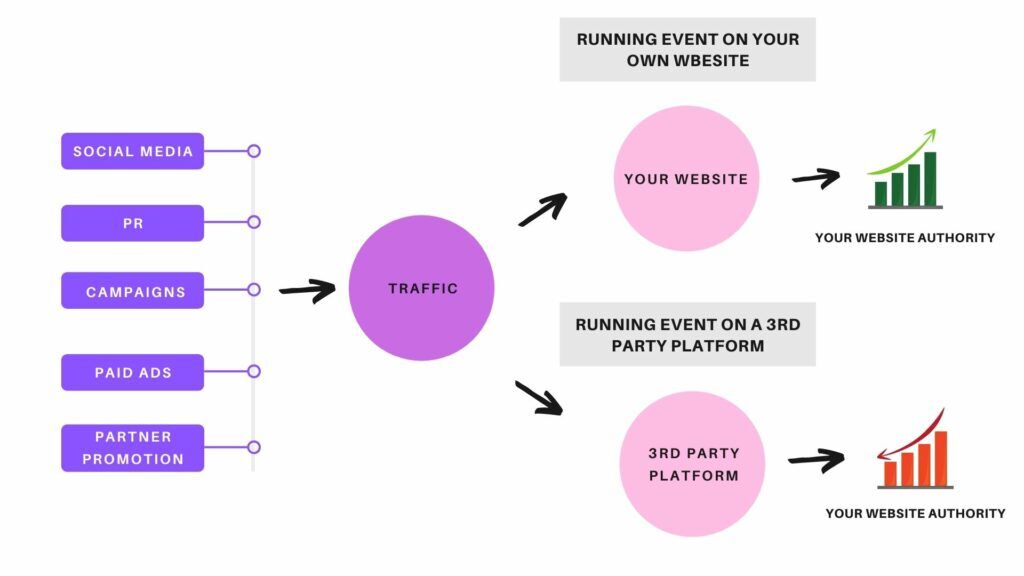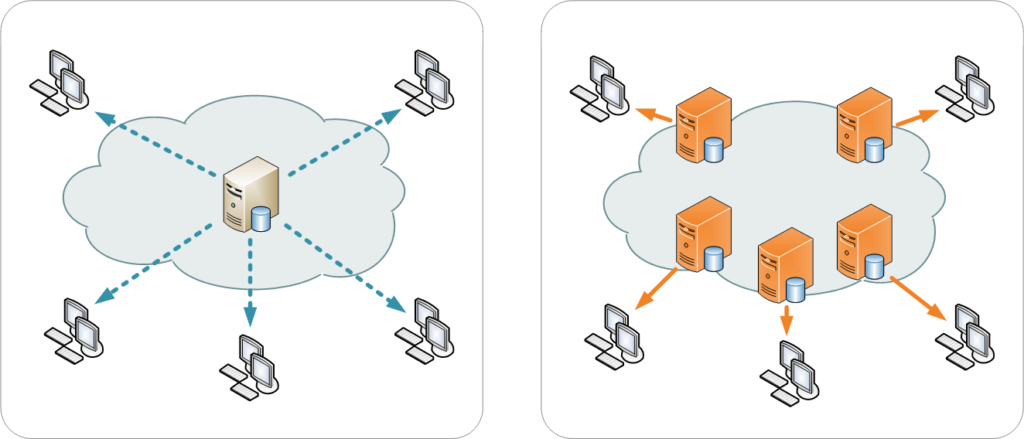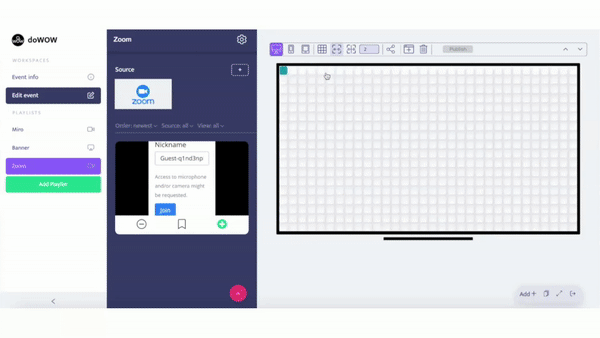Planning and hosting virtual events can be overwhelming as there is simply no platform that is cut out for each and every one of your business objectives. In the age of platforms and tools fatigue, it is useful to go back to basics and focus on the marketing channels that work best for you.
We will focus on WordPress and compatible tools as it is one of the most popular website builders to date. However, the insights are applicable to any other website platform.
In this article, you will find out:
- why running virtual event with WordPress outperform third-party event platforms
- what are the essential features you need to pay attention to run a successful event on your website
- how to leverage existing digital tools to support your event strategy (while keeping budget in mind)
- how to pull the elements together
Why run virtual event with WordPress?
Needless to say, your website is a must-have tool to represent your business, communicate with, educate and attract your audience.
Whatever the size of your company is, your website is a number one online channel where you’re not bound by the terms and conditions of other platforms. It is the destination and focal point of your online presence, and you are not constrained by any rules that a third party platform imposes on you.
Why is this important?
You need website traffic to obtain visitors and convert them into customers. Quite often event organizers place more emphasis on production, content and speaker management and not enough on user experience and funneling website traffic to the right place.
As a result, after running a successful event with many engaged visitors on third-party platforms, they end up wasting an opportunity to gain website authority, retain visitors & turn them into customers.
Remember, Google algorithms love traffic and your website gains authority from it. If you want to show up in Google search results, you need to increase your authority.
Owned vs borrowed traffic
Borrowed traffic. Let’s say you’re building a business by putting content on YouTube – your audience is there and it’s your main channel to communicate with them and generate revenue. However, you’re just renting space – you don’t own your YouTube channel, and at any moment, you may be blocked, banned, or demonetized by factors outside your control.
Owned traffic. Your website, on the other hand, is an asset that you own. You control what’s being said, published or advertised and it is where you showcase your brand to the world. When visitors are spending time on your website, Google’s powerful algorithm calculates this and your page gains more authority.
It doesn’t mean that other platforms should be disregarded. A good marketing strategy should, of course, leverage third-party platforms. But the key is to use them to lead the traffic to your website, the traffic that you will truly own.
Why is owning your traffic important?

Virtual events are a powerful traffic generator. Think about the effort you put into promoting your event, getting people’s attention, gaining more sign ups, etc. You are building a list of potential customers, an engaged community for your brand.
When running your event fully via a third-party event platform, you are also just renting the space. Does it make sense to give away this hard-earned traffic to someone else’s platform instead of gaining more authority and encourage the visitors to remain on your website?
Moreover, most of the third-party event platforms allow to run an event for a limited amount of time (for example, 2 to 72 hours). With hosting your virtual event with WordPress, you are in control of how long you want your event content to stay live.
Can your website handle large amounts of visitors?
An important element to keep in mind to run a virtual event with WordPress website is your website’s bandwidth.
A website’s bandwidth is a measurement of the amount of data your website uses during a specific time period. Bandwidth is affected by the amount of traffic to your website. When a large number of visitors come to your website, it is necessary to make sure that your website is able to host them without disturbances.

The amount and size of the content also influences bandwidth. Normally, your website will load content from your own server. If you have international visitors it can take longer to load the website for them due to the distance between them and your server location.
This problem can be easily solved by using a CDN (content delivery network). CDN allows your website to load from the closest server enabling your site to load quickly and efficiently for your audience, and they will have a better user experience.
For example, doWow allows you to integrate a virtual event with WordPress and it leverages a CDN to distribute your event content. That makes it a 100% fail-proof solution for large amounts of visitors. If you are wondering what would be the most suitable solution for hosting an event on your website, reach out to us to get a free consultation.
What are the essential elements to running a successful virtual event with WordPress?
Once you’ve decided to run a virtual event with WordPress, it is important to define some key features and elements that help you make this endeavor successful.
First and foremost, event format.
Running a conference is different from running a webinar or a workshop. Depending on your goal, you can choose from a variety of event formats, you can also mix and match them:
- conference
- webinar
- workshop
- press conference
- product showcase
- virtual meetup
- hackathon
- training session & many more
Define the elements and features.
Now onto the features and elements of your virtual event. Think about how your audience consumes content and which elements will help you showcase your content appropriately.
- Live stream will most likely be one of the central elements of your event. Depending on your budget, you can either choose to go live via free available tools, OBS or go for more customized solutions and a professional studio;
- Pre-recorded content makes sense if you do not want to live stream your talks and choose to play out content that has already been recorded;
- User-generated content and social media – integrating social media feeds into your event will boost attendee engagement while leading the traffic from social media channels to your event page. Think of the event hashtags you will use across social media platforms;
- Calls-to-action – think of your event visitor journey. How do you want them to interact with your event page once they land there? What is the most simple and convenient way for the user to engage with your virtual event? Think of the calls-to-action that are important for your marketing goals and where you would place them.
- Visuals – from graphic elements to videos, make sure you think of the visual elements of your event. During breaks or inevitable technical hiccups, these elements will keep attendees from leaving your event page.
- Collaborative elements – would you like to engage your attendees in collaborative exercises, brainstorming sessions? If yes, then think about how to tie these collaborative elements into the canvas of the event to avoid overwhelming or distracting attendees from the main action.
- Surveys, polling, Q&As, chats – an important element of the event is to get attendee feedback and help them communicate with you, each other or your speakers. Generating leads while your attendees are on your website is a perfect opportunity to grow business. Prepare your surveys and forms in advance and choose when to plug them in.
- Sponsor and partner content – let’s face it, solely showcasing the logos of your event sponsors or partners is not enough if your business model is to generate revenue through event sponsorships. Go deeper into online marketing opportunities to bring value to your sponsors – lead generation forms, giveaways, direct integration of their products and services into your event will make it easier for attendees to engage.
How to leverage existing digital tools to support your event strategy (while keeping budget in mind)?
We defined some of the important elements of a virtual event. Now it is time to think about the tools that will bring these elements to life. Thankfully, there are numerous tools that don’t cost thousands (or are even free) to choose from. All these tools can be easily integrated into your WordPress:
- Zoom – safe and unbreakable, can handle lots of visitors. With doWow, you can embed your live zoom meetings on your website in just a minute.
- YouTube – go live on YouTube from Zoom and avoid spending additional budget to host more attendees. If you have a YouTube channel, leverage it to show video content you already have during breaks at the event.
- Miro – online collaborative whiteboarding tool that enables your attendees to work together, from brainstorming with digital sticky notes to planning and managing agile workflows. Use it if you run a workshop or a brainstorming session with attendees. It is easy to embed a Miro board on your event page.
- Airtable is another collaboration and planning tool that you can integrate into your event page easily. The tool is often used for planning the team work during hackathons or training sessions.
- Typeform is for building online forms and surveys. On their free plan, you can create an unlimited number of forms but the number of questions is limited to 10. Use it for lead generation forms or feedback surveys and integrate it into your event experience.
- Slido – Q&A and polling platform for live and virtual meetings and events. You can include your own branding and increase the number of participants.
- Calendly – a free online appointment scheduling tool. Try it out to allow attendees to book an appointment with you or your team directly at the event.
- Spatial chat – an online communication tool for networking, coffee breaks and attendee interaction.
- Wonder.me is a virtual space where people can meet and talk. It is great for hosting networking sessions or talks according to the topics of interest.
- Spotify allows you to easily embed playlists on your website – take advantage of it and create your event playlist for attendees to listen to.
Pulling elements together - how to integrate these tools into your WordPress website seamlessly?
The last but definitely not least part of running an event on your website is pulling all the elements and tools together. The key challenge is to create a layout where tools work together seamlessly to enhance event experience without confusing visitors.
doWow does exactly that without the need to involve a developer or writing a single line of code. doWow is a media wall infrastructure that aggregates tools and content into a custom layout that can be placed on any screen, anywhere and moderated in real-time.

The media wall hosts limitless content:
- Live streaming & conferencing tools like Zoom, Crowdcast, Airmeet, YouTube Live, Twitch & more
- Direct streaming to the media wall
- Social media feeds & user-generated content
- Videos, graphics, web widgets
- Calls to action & interactive buttons
- Team collaboration tools like MIRO boards, Airtable
- Entertainment tools like Spotify
You can start by creating your own layout using doWow’s grid editor, adding content and integrating tools and, finally, embedding it directly into your WordPress website – driving the traffic to where it belongs and engaging your visitors.






